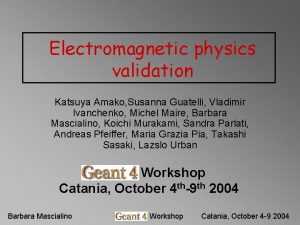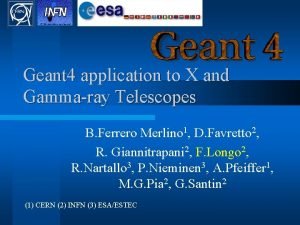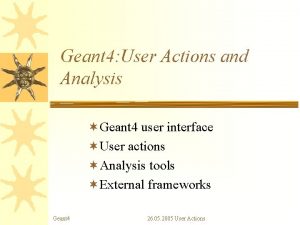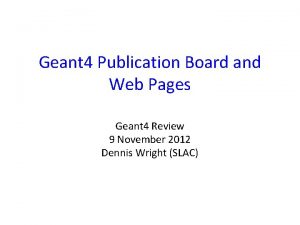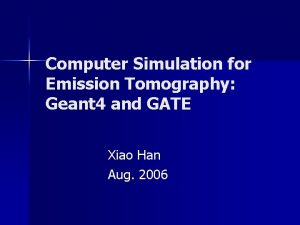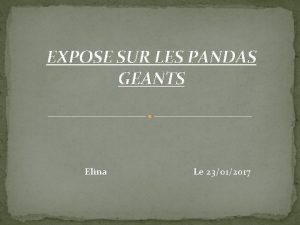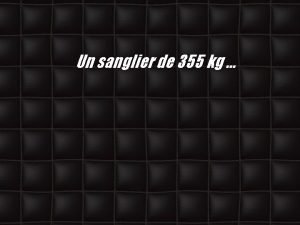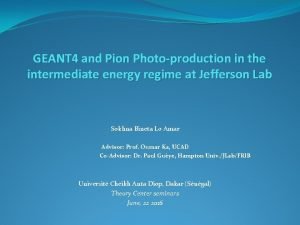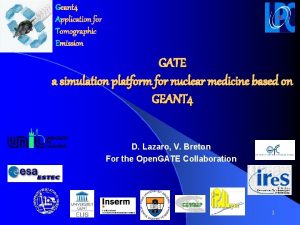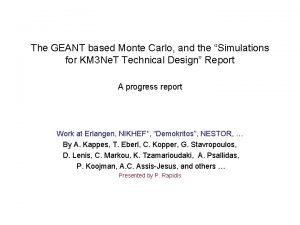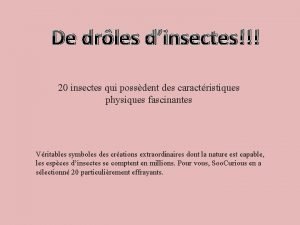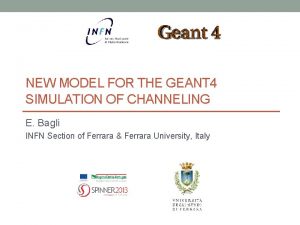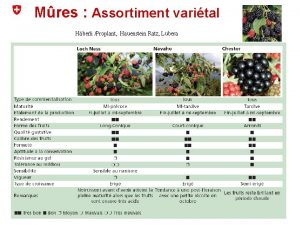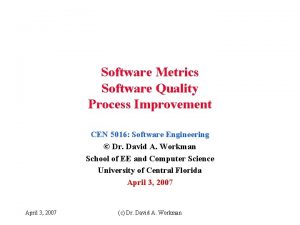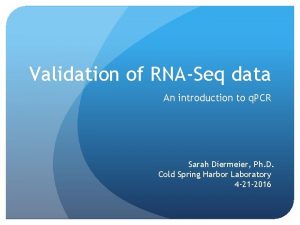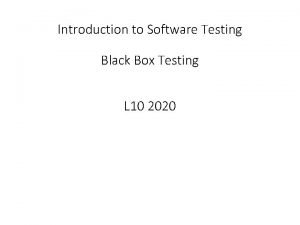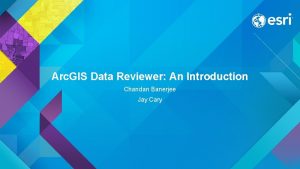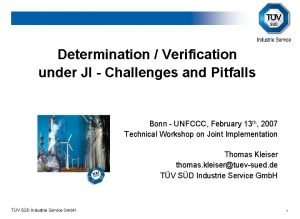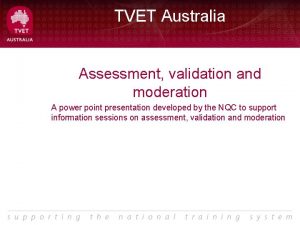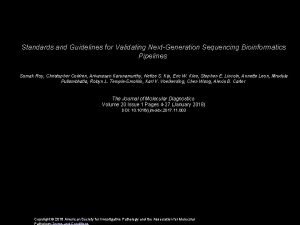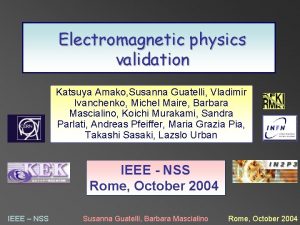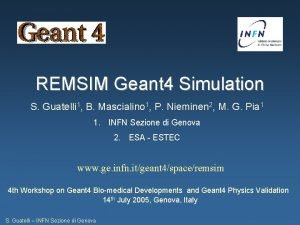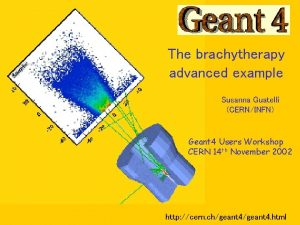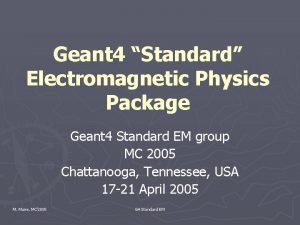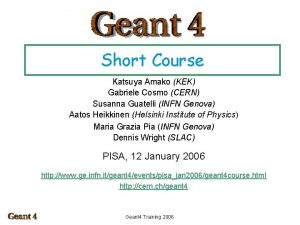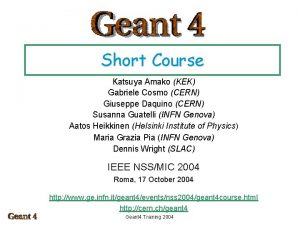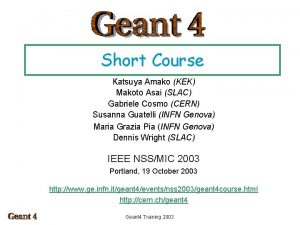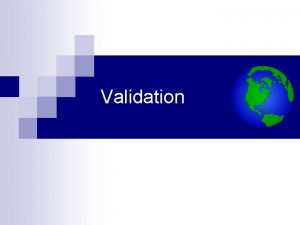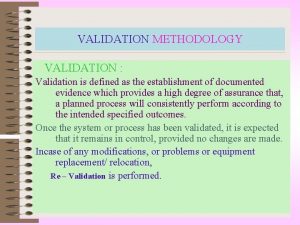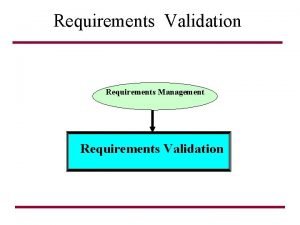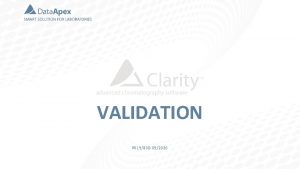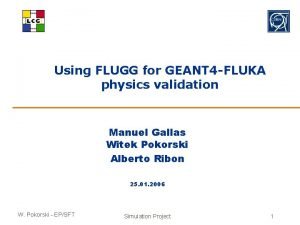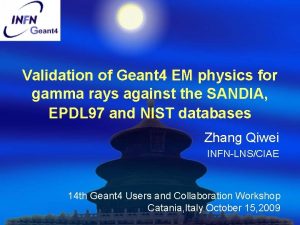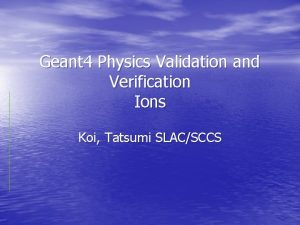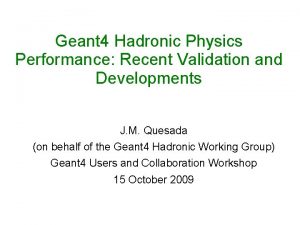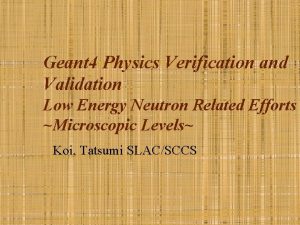Geant 4 Physics Validation K Amako S Guatelli































- Slides: 31

Geant 4 Physics Validation K. Amako, S. Guatelli, V. Ivanchenko, M. Maire, B. Mascialino, K. Murakami, P. Nieminen, L. Pandola, S. Parlati, M. G. Pia, A. Ribon, T. Sasaki, L. Urban et al. Geant 4 Space User Workshop Leuven, 5 -7 October 2005 Maria Grazia Pia, INFN Genova

Geant 4 Physics Models Ample variety of physics models in the Geant 4 Toolkit – complementary and alternative Electromagnetic physics – Standard, Low. Energy, Muon, Optical Hadronic physics – data driven, parameterised and theory driven models Geant 4 Physics Book – on-going project to document the performance of Geant 4 physics against experimental data and in relevant experimental application domains Maria Grazia Pia, INFN Genova

Validation process Geant 4 test process – – Physics packages are subject to unit and system testing Verification, validation of single processes/models performed by Working Groups Validation process – – systematic: cover all models of a given process comparison to experimental data and established reference databases rigorous software process to guarantee quality and reliability statistical analysis Goals – – – evaluate quantitatively the accuracy Geant 4 physics models document their respective strength provide guidance to users to select the models to use in their applications based on sound, objective ground Maria Grazia Pia, INFN Genova

G. A. P Cirrone, S. Donadio, S. Guatelli, A. Mantero, B. Mascialino, S. Parlati, M. G. Pia, A. Pfeiffer, A. Ribon, P. Viarengo “A Goodness-of-Fit Statistical Toolkit” IEEE- Transactions on Nuclear Science (2004), 51 (5): 2056 -2063. Partly funded by ESA (SEPTIMESS Project) Maria Grazia Pia, INFN Genova

Go. F algorithms (currently implemented) Algorithms for binned distributions – Anderson-Darling test Chi-squared test Fisz-Cramer-von Mises test – Tiku test (Cramer-von Mises test in chi-squared approximation) – – Algorithms for unbinned distributions – Anderson-Darling test Cramer-von Mises test – Goodman test (Kolmogorov-Smirnov test in chi-squared approximation) – – Kolmogorov-Smirnov test Kuiper test – Tiku test (Cramer-von Mises test in chi-squared approximation) – Maria Grazia Pia, INFN Genova

Overview of recent activities Geant 4 Physics Book: Electromagnetic Volume – – comparison against the NIST databases K. Amako, S. Guatelli, V. N. Ivanchenko, M. Maire, B. Mascialino, K. Murakami, P. Nieminen, L. Pandola, S. Parlati, M. G. Pia, M. Piergentili, T. Sasaki, L. Urban Comparison of Geant 4 electromagnetic physics models against the NIST reference data IEEE Trans. Nucl. Sci. , Vol. 52, Issue 4, Aug. 2005, 910 -918 Current Physics Book projects (preliminary results) – – Bremsstrahlung final state Atomic relaxation and PIXE Bragg peak Radioactivity from rocks and sands LCG Simulation Validation Project – – focused on hadronic physics see A. Ribons’s talk at EPS-HEP, Lisbon, July 2005 Maria Grazia Pia, INFN Genova

NIST Test Photon Mass Attenuation Coefficient Photon Partial Interaction Coefficient – related to the cross section of a specific photon interaction process Electron CSDA range and Stopping Power Proton CSDA range and Stopping Power a CSDA range and Stopping Power Elements Be, Al, Si, Fe, Ge, Ag, Cs, Au, Pb, U (span the periodic element table) Energy range photon electron proton a 1 ke. V – 100 Ge. V 10 ke. V – 1 Ge. V 1 ke. V – 10 Ge. V 1 ke. V – 1 Ge. V Simulation configuration reproducing NIST conditions (ionisation potential, fluctuations, production of Maria Grazia Pia, INFN Genova secondaries etc. ) Geant 4 models: electrons and photons Standard Low Energy EEDL/EPDL Low Energy Penelope Geant 4 models: protons and a Standard Low Energy ICRU 49 Low Energy Ziegler 1977 Low Energy Ziegler 1985 Low Energy Ziegler 2000 (Low Energy: free electron gas + parameterisations + Bethe-Bloch)

Statistical analysis Goodness-of-Fit test (Statistical Toolkit) Alternative hypotheses under test: Go. F Toolkit Go. F test (χ2 test) H 0: Geant 4 simulation = NIST data H 1: Geant 4 simulation ≠ NIST data Distance between Geant 4 simulation and NIST reference data Test result p-value The p-value represents the probability that the test statistics has a value at least as extreme as the one observed, assuming the null hypothesis is true 0≤p≤ 1 p < 0. 05 Geant 4 simulation and NIST data differ significantly p > 0. 05 Geant 4 simulation and NIST data do not differ significantly Maria Grazia Pia, INFN Genova

Photon mass attenuation coefficient Geant 4 models: • Standard • Low Energy – EPDL • Low Energy – Penelope Reference data: NIST - XCOM Experimental set-up Monochromatic photon beam (Io) Transmitted photons (I) Mass attenuation coefficient in Fe Geant 4 Low. E Penelope Geant 4 Standard Geant 4 Low. E EPDL NIST - XCOM Results All Geant 4 models compatible with NIST p-value stability study Best agreement: Geant 4 Low. E models H 0 REJECTION AREA Maria Grazia Pia, INFN Genova

Compton interaction coefficient (cross section) Geant 4 models: • Standard • Low Energy – EPDL • Low Energy – Penelope Reference data: NIST - XCOM Compton interaction coefficient in Ag Geant 4 Low. E Penelope Geant 4 Standard Geant 4 Low. E EPDL NIST - XCOM Maria Grazia Pia, INFN Genova Results All Geant 4 models compatible with NIST Best agreement: Geant 4 Low. E-EPDL p-value stability study H 0 REJECTION AREA

Photoelectric interaction coefficient Geant 4 models: • Standard • Low Energy – EPDL • Low Energy – Penelope Reference data: NIST - XCOM Photoelectric interaction coefficient in Ge Geant 4 Low. E Penelope Geant 4 Standard Geant 4 Low. E EPDL NIST - XCOM Geant 4 Low. E Penelope Geant 4 Standard Geant 4 Low. E EPDL Maria Grazia INFN Genova NISTPia, - XCOM (cross section) Results All Geant 4 models compatible with NIST Best agreement: Geant 4 Low. E models p-value stability study H 0 REJECTION AREA

Pair production interaction coefficient (cross section) Geant 4 models: • Standard • Low Energy – EPDL • Low Energy – Penelope Reference data: NIST - XCOM Results All Geant 4 models compatible with NIST Pair production interaction coefficient in Au Maria Grazia Pia, INFN Genova p-value (pair production interaction coefficient test) Geant 4 Low. E Penelope Geant 4 Standard Geant 4 Low. E EPDL NIST - XCOM p-value stability study H 0 REJECTION AREA

Rayleigh interaction coefficient (cross section) Geant 4 models: • Low Energy – EPDL • Low Energy – Penelope Reference data: NIST - XCOM Rayleigh interaction coefficient in Be Geant 4 Low. E Penelope Geant 4 Low. E EPDL NIST - XCOM Maria Grazia Pia, INFN Genova Results The Geant 4 Low Energy models look in disagreement with the reference data for some materials EPDL XCOM Penelope XCOM Be 0. 99 1 Al 0. 32 <0. 05 Si 0. 77 <0. 05 Fe 1 <0. 05 Ge <0. 05 0. 39 Ag 0. 36 0. 08 Cs <0. 05 Au <0. 05 Pb <0. 05 U <0. 05

Rayleigh interaction coefficient The disagreement is evident between 1 ke. V and 1 Me. V photon energies Rayleigh interaction coefficient in Au For what concerns the Geant 4 Low Energy EPDL model, the effect observed derives from an intrinsic inconsistency between Rayleigh cross section data in NIST-XCOM and the cross sections of EPDL 97, on which the model is based Differences between EPDL 97 and NIST-XCOM have already been highlighted in a paper by Zaidi, which recommends the Livermore photon and electron data libraries as the most up-to-date and accurate databases available for Monte Carlo modeling. NIST EPDL 97 Zaidi H. , 2000, Comparative evaluation of photon cross section libraries for materials of interest in PET Monte Carlo simulation IEEE Transaction on Nuclear Science 47 2722 -35 Maria Grazia Pia, INFN Genova

Electron Stopping Power Experimental set-up Electrons are generated with Geant 4 models: random direction at the center of the box and stop inside the box • Standard • Low Energy – EEDL Maximum step allowed in tracking particles was set about 1/10 of the expected range • Low Energy – Penelope Reference data: NIST – ESTAR (ICRU 37) value, to ensure the accuracy of the calculation p-value stability study Results All Geant 4 models compatible with NIST and equivalent Geant 4 Low. E Penelope Geant 4 Standard Geant 4 Low. E Livermore NIST - ESTAR H 0 REJECTION AREA Maria Grazia Pia, INFN Genova

Electron CSDA Range CSDA: particle range without energy loss fluctuations and multiple scattering Geant 4 models: Results • Standard All Geant 4 models compatible with NIST • Low Energy – EEDL and equivalent • Low Energy – Penelope Reference data: NIST – ESTAR (ICRU 37) CSDA range in U Geant 4 Low. E Penelope Geant 4 Standard Geant 4 Low. E Livermore NIST - ESTAR Maria Grazia Pia, INFN Genova p-value stability study H 0 REJECTION AREA

Proton stopping power - range Stopping power: p-value stability study Stopping power in Al H 0 REJECTION AREA CSDA range: p-value stability study + Geant 4 Low. E Ziegler 1985 Geant 4 Low. E Ziegler 2000 Geant 4 Standard Geant 4 Low. E ICRU 49 NIST - PSTAR Results Ziegler parameterisations are as authoritative as ICRU 49 ones Maria Grazia Pia, rather INFN Genova Comparison than validation H 0 REJECTION AREA

a stopping power and range CSDA range in Si Stopping power: p-value stability study Geant 4 Low. E Ziegler 1977 Geant 4 Standard Geant 4 Low. E ICRU 49 NIST - ASTAR H 0 REJECTION AREA The complex modeling of ion interactions in the low energy is The complex physics modeling of ion interactions in the low energy range isrange addressed by Energy the Geant 4 Lowand Energy package and represented one of the for by the addressed Geant 4 Low package it represented oneit of the main motivations for developing this package the Maria developing of this package. Grazia Pia, INFN Genova

Bremsstrahlung 3 sets of models: Standard: G 4 e. Bremsstrahlung Low Energy EPDL: G 4 Low. Energy. Bremsstrahlung Low Energy Penelope: G 4 Penelope. Bremsstrahlung 3 angular distributions: Tsai, 2 BS, 2 BN Penelope Standard Penelope TSAI (def) 2 BS 2 BN Low Energy (default) Angle (deg) Angular distribution of photons is strongly model-dependent Maria Grazia Pia, INFN Genova

Reference data Transmitted energy spectrum at two different emission angles for four materials (Al, Pb, W, Ag) Absolute yields are reported (= photons/primary), though with an “odd” normalization R. Ambrose et al. , Nucl. Instr. Meth. B 56/57 (1991) 327 Maria Grazia Pia, INFN Genova The absolute Bremsstrahlung cross section can be tested

Relative comparison. . . Low. EPenelope Intensity/Z (e. V/sr ke. V) Low E EEDL TSAI Photon energy (ke. V) Relative comparison (45 deg direction) Shapes of the spectra are in good agreement Work in progress, will be published Maria Grazia Pia, INFN Genova

Proton Bragg Peak Reference data from CATANA (INFN-LNS Hadrontherapy Group) Geant 4 models: electromagnetic Standard Low Energy ICRU 49 Low Energy Ziegler 1977 Low Energy Ziegler 1985 Low Energy Ziegler 2000 Systematic test in progress Geant 4 models: hadronic Precompound + default de-excitation Precompound + GEM evaporation with/without Fermi Break-up Binary Cascade (including Precompound + de-excitation) Bertini Cascade Parameterised Maria Grazia Pia, INFN Genova Lot of work… Preliminary results

EM only – ICRU 49 ENTIRE PEAK Exp G 4 S 2. 89 2. 43 T 3. 26 3. 83 Go. F test LEFT TAIL ENTIRE PEAK CVM-AD Exp 9. 77 11. 89 T 2. 66 3. 16 CVM-AD Exp G 4 S 3. 89 12. 24 T 1. 03 1. 00 Go. F test S 2. 89 2. 43 T 3. 26 3. 83 Go. F test S RIGHT TAIL X>30 mm G 4 x<=30 mm Go. F test Exp KS-AD Maria Grazia Pia, INFN Genova CVM-AD

EM only – ICRU 49 – Go. F results ENTIRE PEAK (N 1=149 N 2=67) CVM AD Test statistics 0. 112938 0. 853737 p-value 0. 525095 0. 443831 CVM AD Test statistics 0. 0701584 0. 645422 p-value 0. 750593 0. 606120 KS AD Test statistics 0. 333333 0. 816534 p-value 0. 724871 0. 469251 LEFT TAIL x<=30 mm (N 1=140 N 2=61) RIGHT TAIL X>30 mm (N 1=9 N 2=6) Maria Grazia Pia, INFN Genova

EM only – Standard ENTIRE PEAK Exp G 4 S 2. 89 2. 48 T 3. 26 3. 76 Go. F test LEFT TAIL CVM-AD Exp G 4 S 9. 77 12. 86 T 2. 66 2. 86 x<=30 mm Go. F test RIGHT TAIL X>30 mm CVM-AD Exp G 4 S 3. 89 48. 20 T 1. 03 1. 00 Go. F test KS-AD Maria Grazia Pia, INFN Genova

Low. E + precompound default ENTIRE PEAK Exp S 2. 89 T 3. 26 Go. F test LEFT TAIL G 4 CVM-AD Exp G 4 x<=30 mm S 9. 77 T 2. 66 Go. F test RIGHT TAIL X>30 mm AD Exp S 3. 89 T 1. 03 Go. F test G 4 KS-AD Maria Grazia Pia, INFN Genova

ICRU 49 + precompound – Go. F results ENTIRE PEAK (N 1=149 N 2=66) CVM AD Test statistics 0. 06 0. 499375 p-value 0. 79 0. 747452 LEFT TAIL x<=30 mm (N 1=140 N 2=60) CVM AD Test statistics 0. 03 0. 232255 p-value 0. 978972 RIGHT TAIL X>30 mm (N 1=9 N 2=6) KS AD Test statistics 0. 33 0. 901787 p-value 0. 73 0. 413129 Maria Grazia Pia, INFN Genova ICRU 49 only 0. 525095 0. 443831 0. 750593 0. 606120 0. 724871 0. 469251

Nuclear de-excitation alternative models Maria Grazia Pia, INFN Genova Work in progress, more to come…

Radioactive spectrum Studies of environmental radioactivity from rocks and sands at the Gran Sasso Laboratory Geant 4 (Low. E EM) can reproduce very well the results of a calibration with a 60 Co source (in the presence of the sample) sample Lower part of the histogram is not meaningful simulation detector simulation data source Maria Grazia Pia, INFN Genova data

Statistical analysis Anderson-Darling test (for binned data) First peak – – A 2 = 0. 45 p-value = 0. 80 NO DIFFERENCE Second peak – – A 2 = 1. 05 p-value = 0. 33 NO DIFFERENCE Both peaks – – A 2 = 0. 80 p-value = 0. 48 NO DIFFERENCE Maria Grazia Pia, INFN Genova

Conclusion More results available, no time to show them all… Systematic, quantitative validation of Geant 4 physics in progress – – all available models rigorous statistical analysis A lot of work! – – – first paper published several on-going projects limited resources available The validation work provides valauable feedback for the improvement of Geant 4 physics models Maria Grazia Pia, INFN Genova
 Susanna guatelli
Susanna guatelli Geant 4
Geant 4 Action geant
Action geant Gant atlas
Gant atlas Geant network map
Geant network map Pub geant
Pub geant Geant computer
Geant computer Le panda exposé
Le panda exposé Sanglier geant turquie
Sanglier geant turquie Pion geant
Pion geant Gate geant
Gate geant Geant simulation
Geant simulation Geant 4
Geant 4 Plus grosse pelleteuse du monde
Plus grosse pelleteuse du monde Blatte rhinocéros
Blatte rhinocéros Geant 4
Geant 4 Myrtillier géant
Myrtillier géant Why does it happen
Why does it happen University physics with modern physics fifteenth edition
University physics with modern physics fifteenth edition Ib physics
Ib physics Software metrics validation
Software metrics validation Short term goal ncp
Short term goal ncp Scrnaseq validation
Scrnaseq validation Black box and white box testing
Black box and white box testing Gis data validation
Gis data validation Verification and validation
Verification and validation Tvet australia
Tvet australia Compartmentalization interdependency effort validation r
Compartmentalization interdependency effort validation r Backup validation
Backup validation Project scheduling and tracking software quality assurance
Project scheduling and tracking software quality assurance Cozyroc file transfer task
Cozyroc file transfer task Guidelines for validation nextgeneration
Guidelines for validation nextgeneration
